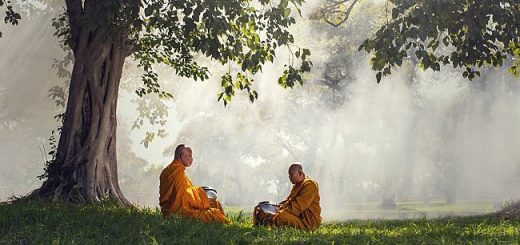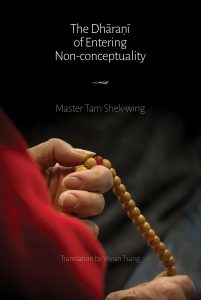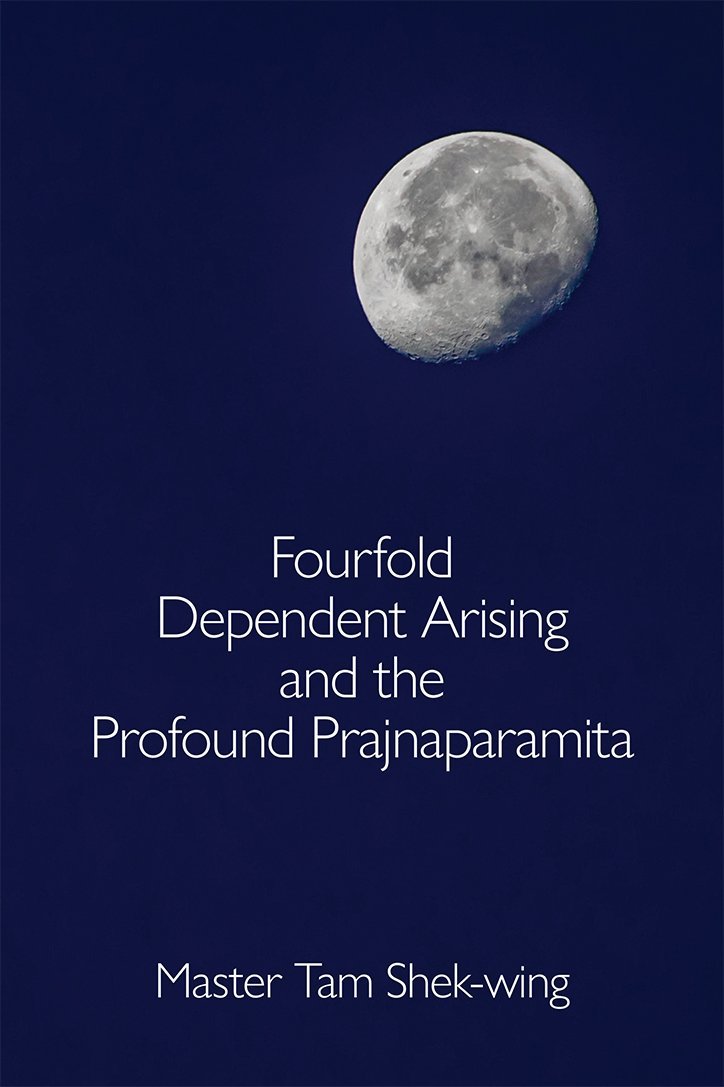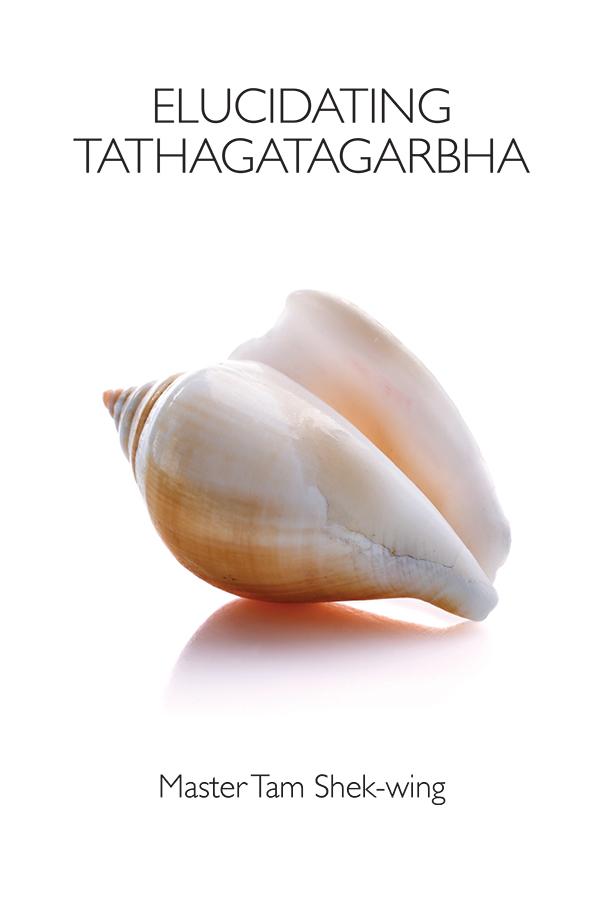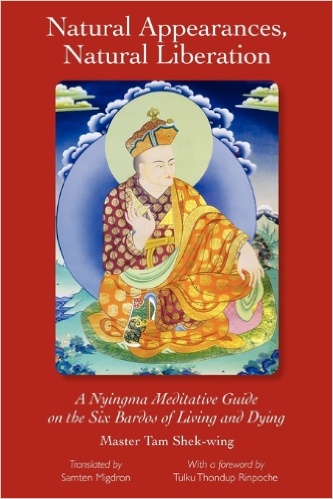An Introduction to “Beyond Words” Series
Translator’s note: Master Tam wrote series of books called Beyond Words (離言叢書) between 2011 and 2021. During this time he published thirteen books of commentary to Buddhist sūtras and treatises using the teaching of Buddha-Within. These books include Saṃdhi-nirmocana-sūtra, The Lion’s Roar of Queen Śrīmālā, as well as Sūtra of Perfect Enlightenment that we are currently serializing on this website. This is a translation of the essay he wrote as a preface to the series. This provides an introduction of the Buddha-Within (Tathāgatagarbha) thought.
I. On the Secret Meaning
The intent for this series is to spell out the secret meaning in Buddhist scriptures. What is the secret meaning? 言外之意, “the meaning that lies beyond the words.” This meaning. It is true that all sutras and treatises are presented through words and sayings, but such words and sayings are only a tool, a conduit of expression, they cannot thusly spell out the true meaning of of Buddha and bodhisattvas. If readers follow strictly only the words in them, what one gets at best is one’s interpretation. One has to break free of the words to know their truth, to thoroughly grasp them.
There’s a verse in Laṅkāvatāra-sūtra:
由於其中有分別
名身句身與文身
凡愚於此成計著
猶如大象溺深泥
Because of the distinction
Between nāma, pada, and vyañjana
The ignorant, the dull-witted, stick to them
Like the elephant in deep mud. (Chapter 2, Verse 172, Suzuki, p. 98)
On Buddha's four reliances. In Mahāparinirvāṇasūtra, Buddha also spoke of the four reliances (rely on the message of the teacher, not on his personality; rely on the meaning, not just on the words; rely on the wisdom, not on conceptuality; rely on the ultimate meaning, not on the provisional one). The emphasis is all on suchness and not on false conceptualization. “Rely on the meaning and not just on the words” illustrates exactly that, the scriptures are about the secret meaning and not only the words. On this issue, Buddha took it seriously, as there were verses dedicated to this point: 彼隨語言作分別 Those who following words, This is a stern warning on the danger of distorting the teaching due to words. The scripture continues: 世尊告言:大慧,三世如來應正等覺有兩種教法義 (dharma-naya),是為言說敎法義 (deśanā-naya)、自證建立教法 (siddhānta-pratyavasthāna-naya)。 The Blessed One said this to him: Mahāmati, there are two forms of teaching the truth attain by the Tathagatas, Arhats, Fully-Enlightened Ones of the past, present, and future (dharma-naya). They are: the teaching by discourses (deśanā-naya), and the teaching by the establishment of self-realisation (siddhānta-pratyavasthāna-naya). 云何為言說教法之方便?大慧,隨順有情心及信解,為積集種種資糧而教導經典。云何為觀修者離心所見分別之自證教法?此為自證殊勝趣境,不墮一異、俱有、俱非;離心意意識;不落理量、不落言詮;此非墮入有無二邊之外道二乘由識觀可得嚐其法味。如是我說為自證。 What is meant by the studying of the discourses is this, Mahāmati: there are various materials and canonical texts and discourses by which sentient beings are taught according to their dispositions and inclinations. What then is the truth of self-realisation by which the Yogins turn away from discriminating what is seen of the Mind itself? There is an exalted state of inner attainment which does not fall into the dualism of oneness and otherness, of bothness and not-bothness; which goes beyond the Citta, Manas, and Manovijñāna; which has nothing to do with logic, reasoning, theorising, and illustrating; which has never been tasted by any bad logicians, by the philosophers, Śrāvakas, and Pratyekabuddhas, who have fallen into the dualistic views of being and non-being – this I call self-realization. (Chapter 3, Suzuki, pp. 148-9) On the secret meaning. Buddha’s secret meaning is a set of teaching established through their inner attainment, expressed through language. The doctrine of Buddha-Within (tathāgatagarbha) is no different. Dharmakaya is beyond logic, reasoning, theorizing, and illustrating. What is seen of the discriminating, judgemental mind is none other than the consciousness realm, a natural dependent arising on dharmakaya. Therefore, dharmakaya is equivalent to the teaching by the establishment of self-realization. The appearance of consciousness realm is like the teaching by discourses. Recognizing the secret meaning of scriptures and treatises is like recognizing dharmakaya. Going by the words only, it is to discriminate by dualistic views, to assert various notions, to impose dualistic labels and meanings upon the nature of dharma, which in turn is a misrepresentation of Buddha’s secret meaning, subtracting from the true nature of dharma. Knowing the importance of Buddha’s secret meaning, it becomes clear that understanding only through words is to impose false conceptualizations upon the inner wisdom realization that is non-conceptual. By asserting notions, the realm of wisdom has also become dualistic. This is why Buddha took it so seriously. Following this line of thinking, the approach to reading Buddhist scriptures is to see pass the sayings to arrive at the secret meaning. Here, while we emphasize to go beyond the wording, it doesn’t mean to do away with words and expressions altogether. If we get rid of language completely, then it’s equivalent to not read the scriptures at all. To read without being trapped by the sayings is to enter the secret meaning, which is in essence the Buddha-Within, the coalescence of wisdom and consciousness, which is also the teaching of non-duality as transmitted by Bodhisattva Mañjuśrī. We can illustrate this coalescence more simply. Buddha's inner realization of wisdom. Buddha’s inner realization of wisdom is also called Tathāgata’s dharmkaya. Here, “kaya” also means “body,” but this “body” is only a state-of-mind and not how we conventionally perceive it as an entity. This state-of-mind, this mental realm, it is Buddha’s realm of inner realization of wisdom. It cannot be understood or analyzed with the concepts within the territory of consciousness, nor can it be seen or heard. A verse in Diamond Sūtra says the following: 若以色見我 To see me in form Forms and sounds are manifestations of consciousness. To see Tathāgata’s dharmakaya, to get a glimpse of Buddha’s inner realm of wisdom, it is to assert notions over this wisdom realm, which is also considered the wrong path. Tathāgata’s dharmakaya cannot be seen because it is utterly beyond consciousness. To say that dharmakaya can only manifest itself through consciousness, it is manifestation because of the coalescence of wisdom and consciousness. The secret meaning in the scriptures is like dharmakaya, it does not manifest itself except through language, which is also a manifestation due to this coalescence of wisdom and consciousness. If fallen strictly within the bounds of language, then it is as in the verse, “to see me in form, to seek me with sound,” naturally wisdom is beyond reach, the secret meaning is beyond reach. Without getting rid of words to see the secret meaning is a seeing due to this coalescence. There is yet another verse in the Diamond Sūtra: 應觀佛法性 The Buddha-nature should be observed Dharmakaya does not depart from the nature of dharma (“teacher’s dharma body”). To see without departing the nature of dharma, it is a seeing through the coalescent realm, which is also the secret meaning of the teaching of non-duality, that the contaminated dharma and the pure nature of dharma are non-dualistic. In the coalescent realm of wisdom and consciousness, dharma and dharmata are non-dualistic. On the TV screen analogy to the coalescence of wisdom and consciousness. This coalescent realm of wisdom and consciousness, the realm of Buddha-Within, I have often used the analogy of the TV screen and the images on it, where the TV screen is analogous to dharmakaya, the wisdom realm; upon dharmakaya consciousness is the natural dependent arising, which is analogous to the images on the TV screen. When we observe the images on the TV screen, knowing the existence of the TV screen, it becomes clear that the consciousness realm is an appearance without departing from the wisdom realm – images appear on the TV screen). Therefore, there is no need to be rid of the images to observe the TV screen – there is no need to be rid of the words to observe the secret meaning. We only have to know that the TV screen makes an appearance through the images on it – the secret meaning depends on the expressions to make an appearance – this way, we can also become acquainted with the TV screen – to get to understand the secret meaning. This is as the verse says, “The Buddha-nature should be observed / As the teacher’s dharma body,” which is also represented in the four reliances by “rely on the meaning, not just on the words”; “rely on the wisdom, not on conceptuality”; “rely on the ultimate meaning, not on the provisional one.” Simply, the sayings and the secret meaning are coalescent. Not recognizing the Buddha-Within, not knowing the coalescence of wisdom and consciousness, then the secret meaning of scriptures is also beyond reach. To see Buddha’s secret meaning, one must understand the Buddha-Within; Buddha’s secret meaning is also said to be the Buddha-Within. Master Lü Cheng from the China School of Inner Classics (支那內學院) said the following in the Lectures on Laṅkāvatāra-sūtra: 此經待問而說,開演自證心地法門,即就眾生與佛共同心地為言也。 自證者,謂此心地乃佛親切契合而後說,非臆測推想之言。所以說此法門者,乃佛立教之本源,眾生入道之依。 (《呂澂佛學論著選集》卷二,頁 1217,齊魯書社,1991。) This sūtra came from a line of questions, leading to an illustration of self-realization, the dharma entrance of the ground of mind, in other words, it is said to be the common ground of mind between sentient beings and buddhas. By self-realization, it is the ground of mind that is directly engaged by Buddha, and not through speculation and logical reasoning. We can conclude that this dharma entrance is the authentic source of Buddhism, the basis for all sentient beings to enter the path. More on Lü's thought on the Buddha-Within. This is to show that Lü indeed knew the secret meaning of Laṅkāvatāra-sūtra. He later further said: 四門所入,歸於一趣,即如來藏。佛學而與佛無關,何貴此學,故四門所趣必至於如來藏。此義極為重要。 (同上,頁 1261。) The four entrances lead towards the same direction, the Buddha-Within. If the Buddhist teaching has nothing to do with Buddhahood, then what good is it? Thus the four entrances must lead towards the Buddha-Within. This meaning is of utmost importance. The “four entrances” refer to the “eight consciousnesses,” “five dharmas,” “three natures” and “two selflessnesses” in Laṅkāvatāra-sūtra. Lü believed that they are underlying about the Buddha-Within, otherwise, they are irrelevant to the Buddhist practice. Therefore, he also said: 如來藏義,非楞伽獨倡,自佛說法以來,無處不說,無經不載,但以異門立說,所謂空、無生、無二、以及無自性相,如是等名,與如來藏義原無差異。(同上。) The teaching of the Buddha-Within is not only advocated in Laṅkāvatāra-sūtra. Since Buddha began teaching, there is not a single teaching or scripture that does not talk about it, except that he taught other entrances to establish it, such as emptiness, non-arising, non-duality, and even the insubstantial characteristics. These labels are in essence no different from the meaning of the Buddha-Within. Buddha’s teaching is never departed from the Buddha-Within, no Buddhist scripture is not about the Buddha-Within. This is the secret meaning, spoken according to the inner self realization of wisdom, illustrated through many different other entrances such as emptiness and non-arising. These are 言說敎法義 (deśanā-naya) or teachings by discourse. The four entrances carry the secret meaning of the Buddha-Within in their core. Lü spoke of the four entrances this way: 前之四法門亦皆說如來藏,何以言之?八識歸於無生,五法極至無二,三性歸無性,二空歸於空性,是皆以異門說如來藏也。 The four entrances illustrate the Buddha-Within. Why? The eight consciousnesses are ultimate non-arising; the five dharmas are ultimate non-duality; the three natures are about naturelessness; the two insubstantialities are about emptiness; they are various discourses to teach the Buddha-Within. This way, the four entrances are already inclusive of all scriptures and treatises. Regardless of the entrance, they never depart from the territory of the Buddha-Within. Now let me present an overview of the Buddah-Within. Three levels of understanding Buddha-Within. Buddha-Within can be understood in levels: Regarding the third level of understanding, we can explain further. More on the coalescence. Tathāgata’s dharmakaya manifesting through consciousness, this saying embeds within more secret meaning. All sentient and non-sentient worlds cannot separate from the wisdom realm to manifest themselves, because they all depend on the function of dharmakaya. This function is labelled as the virtue of dharmakaya. More precisely, it should be said this way: upon dharmakaya there is the natural dependent arising of consciousness realm. When said this way, there are two layers of secret meaning: 1. Dharmakaya is embedded within the virtue of dharmakaya; 2. In spite of this virtue, the arising of consciousness realm has to be in accord with “dependent origination.” Manifesting as the consciousness realm, it dwells in the wisdom realm of dharmakaya. The two realms coalesce, which then can be called the coalescent realm of wisdom and consciousness. What does it mean by “coalescence”? Here we can use the analogy of a hand. The palm and the back of the hand are not the same thing, and yet they cannot separate from each other. We call them “neither the same nor different.” This state of affairs we call it coalescence. The wisdom realm of dharmakaya has the natural dependent arising of the realm of consciousness. The wisdom realm and the consciousness realm are not the same, but they are inseparable. There is not a consciousness realm that can establish itself departed from the virtue of dharmakaya. This way, it can also not be departed from dharmakaya to establish itself. This is the coalescence of wisdom and consciousness. Functioning Aspects of Wisdom and Consciousness. What kind of capacity of dharmakaya to allow the consciousness realm to establish itself? 1. It is the vitality that pervades everywhere. Without vitality, no consciousness realm can arise. We call this “the manifestation aspect” (現分). 2. The capacity to allow the diversity of manifestation, like no two people are the same, two different trees can be distinguished from each other – the consciousness realm is endowed with diversity, which is a capacity of dharmakaya called “the luminous aspect” (明分). “Luminous” means that the differences are obvious, clear distinctions can be made. While the wisdom realm comes with such capacities, the consciousness realm is endowed with its function as well, which is dependent arising (隨緣). It means that manifestations are possible due to dependent arising. Here, dependent arising does not only mean a collection of causes and conditions. Nowadays, people may say that a house is made of wood and bricks and stones; a teacup is made of clay by a ceramicist, etc. Here, we refer to the profound dependent arising called “mutual obstruction.” The establishment of all matters depends on adaptations to conditions and limitations (“mutual obstruction”). For example, in our world, the air that we breathe, natural phenomena such as wind and rain and thunder, these are all adaptations to obstructions. Adaptations to time and space in particular, we are lifeforms of three-dimensional space, therefore we must also have three dimensions to survive this world. This level of dependent arising is said to be of the utmost secret, which is not revealed carelessly. In the olden days, this level of dependent arising cannot be easily understood by ordinary people. But these days, this should not be an extraordinary secret anymore. This way to understand the Buddha-Within, then one should also understand the coalescent realm of wisdom and consciousness. The two can be said to be synonymous. As well, to speak of the coalescent realm of wisdom and consciousness would also illustrate Mañjuśrī’s teaching of non-duality. We have briefly illustrated the secret meaning, as the coalescence of wisdom and consciousness, as the Buddha-Within. As well, we have illustrated according to Master Lü Cheng the notion of “no scriptures are not a vehicle of the Buddha-Within” (無經不載如來藏). This is to say that even for scriptures that do not directly speak of the Buddha-Within, they still carry the secret meaning of it. They can illustrate using various dharma entrances, but what is expressed is ultimately the Buddha-Within (the entrance to non-duality 不二法門 ). When we study the scriptures, we should glean from the different alternative discourses this secret meaning. Take emptiness as an example. What is the ultimate meaning of emptiness? Knowing the meaning of the Buddha-Within, we can understand this way. All consciousness realm has dharmakaya as the foundation. The function of this foundation is natural dependent arising. This arising appears as “being” or “existent,” thus the saying “dependent arising.” This dependent arising manifests as “existent” and not “emptiness.” Then what gives rise to the expression “emptiness”? This comes from being rooted in dharmakaya as the foundation. Śakyamuni referred to dharmakaya as emptiness with the analogy of the vast expanse, with an emphasis that it is the only appropriate metaphor, all other metaphors are inappropriate. Then, the foundation of dharmakaya (“primordial foundation” 本始基) is the foundation of emptiness (空性基), all realms of consciousness arisen on this foundation has the nature of emptiness. Just like the moon reflection on water, it has water as the foundation, the image can only be of the nature of water; mirror images have the mirror as the foundation, the image can only be of the nature of mirror. This way, one also arrives at the ultimate meaning of emptiness. The above example should illustrate how the various doctrines ultimately lead to the Buddha-Within. Departed from the Buddha-Within, one also risks losing the ultimate meaning. This series aims to explain Buddhist scriptures according to the Buddha-Within, presenting the secret meaning to readers. This is my attempt to explain words to become free from words, which is of course not that easy. My approach may fail. Readers are welcome to make suggestions so that I can improve in the future. Tam Shek-Wing
即於法性作增益
以其有所增益故
其人當墮入地獄
Discriminate and asserting various notions
They are bound for hell
Because of their assertions. (Chapter 3, Verse 34, Suzuki, p. 135)2. The Coalescence of Wisdom and Consciousness
以音聲求我
是人行邪道
不得見如來
To seek me with sound
This person is following the wrong path
Never to get a glimpse of Tathāgata
即導師法身
法性非所識
故彼不能了
As the teacher’s dharma body.
The nature of dharma cannot be
Understood by conceptualizing it.3. A Short Discussion on the Buddha-Within
4. Concluding Remarks
Written on the May 19, 2011 on my 77th birthday.

